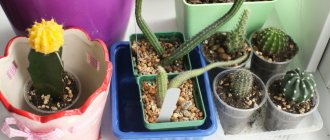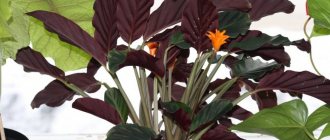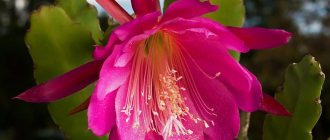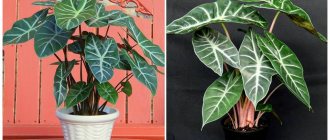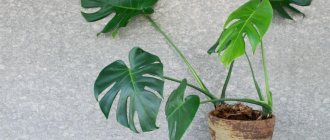Nepenthes is an ornamental deciduous herbaceous plant from the Nepenthes family.
It has two types of leaves: regular and modified - in the form of large jugs with a lid. The plant traps insects and small animals in them. Kills and digests them, obtaining useful substances from the victims’ bodies. Nepenthes is native to Southeast Asia. In their natural environment, perennial vines are common in the tropical zones of Australia, New Guinea, and the island of Madagascar. Here they grow up to 20 m. At home, nepenthes develops quickly and during the first year of life it already becomes an adult shrub, reaching 0.65 m in 4.5 years.
In the wild, the plant blooms with small flowers collected in inconspicuous long racemes. Domestic Nepenthes blooms extremely rarely.
If you like to grow fruit plants at home, then watch how to grow lemon.
| The growth rate is fast. A young flower becomes mature in 1 year. |
| Rarely blooms at home. |
| The plant is suitable for an experienced gardener. |
| It is a perennial plant. |
Nepenthes - what kind of predatory flower is this?
The pitcher plant is part of the Nepenthaceae family. There are 7 officially recognized and 247 unofficial species in the genus.
The plant's homeland is New Guinea, Madagascar, the Philippines and Sumatra. Today the growing area is Sri Lanka, Malaysia, northern India, the islands of the Pacific and Indian Oceans.
Nepenthes. Appearance
Brief description of Nepenthes, what it looks like
Nepenthes is an evergreen vine up to 20 meters long, which sometimes grows as a shrub.
The plant has green, oblong foliage with rounded ends. The length of each leaf is up to 30 cm. Small hanging jugs are available in various tones with specks or stripes.
Each of these jugs has its own lid that protects it from raindrops and debris. The flowers are small, inconspicuous, brown or greenish in color.
At the bottom of the jugs there is fragrant nectar secreted by the walls. It attracts the attention of insects, which climb inside and drown in the sweet liquid. And plants absorb dead insects and thereby receive organic nutrition in addition to the nutrients obtained from the soil.
Kinds
Scientists count about one hundred and twenty species of Nepenthes flycatcher. The most popular of them are grown at home or in the garden.
Winged
The shoots spread four meters from the plant. The leaves are dark green in color. The jugs have a diameter of up to eight centimeters. They are green and spotted. This species grows in the Philippine Islands.
Madagascar
The maximum height of the bush is ninety centimeters. The leaves are green. The jugs reach twenty-five centimeters and have a crimson color.
Attenborough
The height of the plant does not exceed one and a half meters. leaves grow on small petioles. The jugs are very voluminous. They hold about one and a half liters of juice. They are twelve centimeters in diameter.
Raflesi
The leaves of the crop are larger than those of previous species. They are approximately fifty centimeters in size. The jug is green in color with small red spots. The color inside is blue. They are ten centimeters in diameter each.
Rajah
Of all the species of Nepenthes predator, this species is the largest. The shoots extend from the plant at a distance of up to six meters. The leaves are located on them at the same distance. The jugs are dark red in color and more than fifty centimeters in diameter.
Truncated
Grows in the tropics of the Philippine Islands. The leaves are large and have a blunt end. The jugs are brown with a hint of green. They can be about fifty centimeters long.
Varieties of Nepenthes
Nepenthes carnivore plant - home care
The plants presented below are most often found at home.
Nepenthes Winged or Alata
An attractive predatory vine with four-meter stems and light green, sessile leaves.
Grown indoors as an ampel flower. Nepenthes Alata is distinguished by a variety of pitchers of different colors, 18–25 cm high.
Neperthes Winged (Alata) is a predatory vine with multi-colored pitchers
Nepenthes Raja
A huge carnivorous plant with large pitchers. Each of them holds 3.5 liters of water and 2.5 liters of digestive fluid.
Large, brownish-burgundy traps spread along the ground and, in addition to insects, hunt for vertebrates. The height of the jugs is about 40 cm, diameter - 20 cm. They are located on thin flexible combs. Rajdi leaves are green.
This is interesting! Nepenthes Raja can “eat” even a small vertebrate.
Nepenthes Rajda - plant appearance
Nepenthes hookeriana
A hybrid whose name owes to the botanist Joseph Hooker, who compiled its detailed description.
The plant is used for home cultivation. Under comfortable growth conditions, suitable temperature and humidity, having passed the initial stage of development, the flower will later show its best sides.
Nepenthes Pitcher
Prefers swampy climate.
There are no special requirements for the content. It develops well at home.
Nepenthes Sanguinea
Develops quickly. The leaves are evergreen, glossy.
The pitchers are medium-sized, up to 20 cm high; in adult individuals they are much larger. Traps of different colors and shades.
Indoors, flowers are hung in pots, causing the jugs to hang down. Proper care ensures long-term residence in the home.
Nepenthes is grown at home as a hanging plant.
Reproduction methods
Growing from seeds
Growing indoor nepenthes from seeds is not difficult. However, it is almost impossible to obtain high-quality seed material. And buying from an unverified seller is also dangerous, since you can spend a lot of money on the seeds of a completely different plant.
Another difficulty in growing nepenthes from seeds is that they lose their viability quite quickly (after 15–20 days). However, if the seeds are of high quality and fresh, then your chances of growing nepenthes will increase dramatically.
Take a small plastic container with holes for drainage and fill it with moistened sphagnum moss, which should be rinsed thoroughly and microwaved for 2 to 3 minutes to disinfect. Take the seed material and distribute it evenly on the surface of the moss. Water the crops with a fine spray, after which they are placed in a plastic box and covered with a lid on top, which should be transparent. This will help maintain the required high air humidity.
Harvest the crops in a mini-greenhouse, which is placed under phyto-lamp. Ventilate the crops daily, and do not forget to regularly measure the humidity and air temperature, which should be at 90–100 percent and 20 degrees, respectively. After the seedlings appear, they need to be provided with the same care as seedlings of other exotic plants. However, it takes several weeks to adapt the seedlings to the conditions of your apartment.
Nepenthes from seeds
Cuttings
It is much faster and easier to propagate such an unusual plant by cuttings. For example, for rooting you can use the sections remaining after spring pruning. Ideally, there should be 3 leaf blades on the cutting. Shorten them by two thirds. The small upper leaf plate of the apical cutting does not need to be removed.
The lower part of the cuttings is kept in Kornevin’s solution for half an hour, after which the cut areas are sprinkled with coal, crushed to a powdery state. Take a small container, which should be thoroughly washed with bleach, then rinsed with distillate. Also, to plant cuttings for rooting, you will need a special soil mixture consisting of 2 parts sphagnum, 3 parts coconut fiber and 5 parts peat, and a little vermiculite is added to it. Disinfect the resulting mixture, moistened with distilled water, in the microwave for a quarter of an hour.
Bury the lower part of the cutting into the substrate by at least 0.5 cm. After this, gently compact the soil mixture around it slightly and water with distillate. The cutting itself is treated with a solution of Fundazol from a spray bottle. Then the container with the cutting is covered on top with a transparent cap (transparent bag, glass jar, etc.). After this, it is placed in a well-lit and warm (about 23 degrees) place. After a couple of weeks, spill the soil mixture and treat the cuttings with a spray bottle of Zircon solution (2 or 3 drops of the product per 200 milligrams of distilled water).
Cuttings take root within 4–6 weeks. However, after a couple of weeks, you can already evaluate the result: if the cuttings have given roots, then they will have new sprouts with jugs, and if the segments have darkened, then they can be thrown out. Only 1 year after rooting, you can carefully transplant the flower into a permanent pot using the transshipment method.
Nepenthes Ventrata: cuttings, bush formation, rooting and growth of a young plant.
Dividing the bush
To propagate Nepenthes, they also use the method of dividing the bush during transplantation. But be extremely careful, because the root system can be seriously injured, as it is very fragile and delicate. The bush of this vine must be divided in the same way as other plants.
Nepenthes - home care
Many types of plants are capricious. Therefore, caring for Nepenthes requires compliance with the conditions for keeping a tropical plant.
Illumination and temperature conditions
Ficus Natasha - description of the flower and rules of care at home
The best place for the plant is a south or west window. Bright but diffused light is needed. Therefore, direct sunlight is excluded. In such a situation, Nepenthes is shaded.
When choosing windows facing east or west, you need to provide additional lighting, especially in the autumn-winter period. Nepenthes is a plant of tropical origin, so ideal conditions require 14–16 hours of daylight.
The growing temperature of the heat-loving plant is maintained at 22–25°C throughout the year.
Attention! For the normal development of the nepenthes flower, the room is constantly ventilated, but care must be taken to ensure that there are no drafts or flows of cold air.
Watering rules and humidity
Like any tropical plant, the flower prefers abundant watering and high humidity. The soil is constantly moistened, but stagnation of liquid must be avoided.
Watering is carried out with settled water at room temperature. The best liquid for irrigation is rain or melt water. The pot must have a drainage device. In winter, water less often, but monitor the condition of the earthen clod so that it does not dry out.
Nepenthes is sprayed only until the pitchers appear. If this rule is violated, water gets inside the jug, leading to changes in the digestive fluid. And as a result, insects die, but are not digested, but rot inside the traps. In this case, the flower does not receive enough organic matter.
To increase humidity, use a tray with pebbles or peat
Depending on the type of nepenthes, humidity varies between 40–90%. If necessary, it is increased using a tray with wet pebbles or peat, and the foliage is carefully sprayed with water.
Feeding Nepenthes, what to feed the plant
To feed a mature plant during the growing season, use mineral fertilizers with a low nitrogen content. Feed twice a month.
For foliar feeding, use a product for orchids, but reduce the dosage by 3 times. Spray twice a month. You should not allow the solution to come into contact with the jugs, but only moisten the leaves.
Organic feeding
Organic matter is added directly to the jug. It could be a fly, a mosquito or a butterfly. The procedure is performed carefully so as not to overfill the liquid from the trap. If this problem occurs, add distilled water in a small volume. But it is not recommended to place insects there.
Transplantation and flower container size
Predatory nepenthes is replanted once every 2 years. If the rhizome grows quickly, replant it annually. The procedure is carried out in mid-spring, using the transshipment method.
Attention! The tap root of the Nepenthes plant is quite fragile. When transplanting, you should protect it from damage.
The soil is purchased at the store. A good option is soil for orchids. More often, soil is made independently from the following components:
- sphagnum moss;
- coconut fiber;
- crushed pine bark;
- peat;
- quartz sand;
- perlite
The components are taken in the ratio: 4:3:3:1:1:1. The contents are mixed and disinfected in the oven for 20 minutes at 200°.
Nepenthes is transplanted into a pot increased by 30 mm in width. The bottom is covered with expanded clay or pebbles. This is followed by a small amount of prepared soil into which the roots are immersed. The remaining soil is laid in a circle around the roots, compacted and mulched with moss.
Flower pruning and winter dormancy
Pinching and pruning are mandatory procedures for crown formation. The first pruning is carried out when the sixth leaf appears. Long loops and shoots are removed, supports are installed. The flower will wrap around them.
From the beginning of October to February, Nepenthes is dormant. At this time, the flower is not watered and feeding is reduced.
Additional Information! Sufficient humidity at the winter dormancy stage is 50%.
General description with photo
Nepenthes from the Nepentheaceae family is a representative of mixotrophs - plants with a special type of nutrition, capable of obtaining what they need for life from different sources, depending on the circumstances. This method of nutrition has been formed over many centuries and is due to the harsh conditions of natural growth. The inflorescence of Nepenthes is a closing vessel, which also increases in size as it grows and develops. Nectar is produced inside the flower, the aroma of which attracts insects. However, once they are trapped, they cannot get back out. Dead insects or rodents dissolve under the influence of this nectar, and the plant takes from these remains everything it needs for its development.
However, calling pitcher traps flowers is not entirely correct; in fact, they are modified leaves. They can look very different in shape, color and size, depending on the variety.
How does Nepenthes reproduce?
Bougainvillea - care and maintenance in open ground
At home, you can propagate a flower in several ways, which are chosen by the gardener.
- Seeds
At home, Nepenthes reproduces by seeds
This method is rarely chosen, as it requires a lot of effort and time, but does not always lead to success.
The bottom of the container is covered with cleaned moss. Distribute the seeds, moisten them and cover them with film. Maintain humidity in the artificial greenhouse up to 90%, temperature up to 20 °C. The phytolamp is turned on from above for 12–14 hours a day.
Wait until 2-3 leaves appear and plant them in individual pots.
- Apical cuttings
Propagation by cuttings
Propagation by cuttings is a simple and effective method. It is carried out in the spring, when the first leaves have already appeared on the shoots.
A cutting with 3 leaves is cut, treated with foundation, and planted in the ground. Cover the top with a glass jar or plastic bottle. Maintains temperature and humidity. Ventilate and spray regularly.
- Air layering
The method is as follows. Place a container with soil near the flower pot. The long shoot is tilted and secured so that it rests on nutrient soil. Moisturize regularly.
After 2–3 weeks, roots form on the shoot. They are separated from the main individual and planted in pots.
- Root layering
Perform the method of propagation during transplantation. The root system is divided into parts, which are rooted in separate pots. The method requires experience and knowledge. When dividing a bush, the roots can be injured.
Suitable containers
To grow Nepenthes, you can use a variety of dishes:
- clay pots,
- baskets,
- cylindrical pieces of bark, etc.
The main rule for growing Nepenthes is to ensure excellent drainage. Remember: drainage should occupy at least a quarter of the height of the pot. Use as drainage:
- broken shards,
- expanded clay,
- clean bark (2-3 cm fraction).
When planting nepenthes, a layer of drainage is placed on the bottom of the dish, then a layer of fresh substrate. Place the plant with straightened roots on the substrate and cover them with a layer of substrate, leaving approximately 2 cm to the edge of the pot. The best time for planting and transplanting nepenthes is spring.
Problems of raising a predator, diseases and pests
Nepenthes pests are rare. Much more often the plant gets sick due to improper care.
Problems in growing:
- Fungal diseases appear against the background of errors in watering and high humidity. The disease is identified by brown spots on the leaves. For treatment, fungicides are used.
- If the leaves turn yellow and fall off, the problem is insufficient humidity or incorrect temperature.
- From excess liquid, the roots and leaves rot, and the stems turn black. To save the flower, take it out of the pot and cut off the rotten roots or leaves. The sections are sprinkled with crushed coal and the plant is planted in a new pot with a sterile substrate. And to obtain a new nepenthes, cuttings from the plant are rooted.
- When there is insufficient light, the pitchers slow down in growth or stop forming.
- When the soil is poor, containing only peat and moss, a disease called chlorosis begins.
Nepenthes at home
Important! Sterile instruments are used to trim rotting leaves and roots to avoid infection in open sections.
Among the pests, the crop is dominated by aphids and mealybugs. Insects are removed with a cotton swab soaked in alcohol (60%).
Only with proper maintenance of the flower, regular care and inspection, will an interesting tropical plant grow, attracting others with its unusual appearance and methods of survival.
Application
Nepenthes were used in a variety of ways. Their liquid can serve as a pleasant drink, and the shoot can even be used as a building material, and tropical residents cooked rice in its jugs.
In folk medicine, the juice is used as a cough suppressant and for bladder inflammation, eye disease and skin inflammation. Decoctions from the roots and stems are drunk for dysentery or malaria.
Sources
- https://womanadvice.ru/nepentes-uhod-v-domashnih-usloviyah-i-interesnye-fakty-o-rastenii-hishchnike
- https://agronomu.com/bok/3824-nepentes-kak-uhazhivat-za-hischnikom-v-domashnih-usloviyah.html
- https://landshaftportal.ru/nepentes/
- https://floral-house.ru/dekorativno-listvennye/nepentes-khishchnoe-rastenie-opisanie-ukhod-v-domashnikh-usloviyakh.html
- https://chvetochki.ru/nepentes/
- https://Potted-Plants.ru/nepentes/
- https://tobehome.ru/komnatnii-rasteniya/nepentes-vyrashhivanie-i-uxod-v-domashnix-usloviyax.html
- https://myhouseplants.info/dekorativno-listvennyie-rasteniya/nepentes/
- https://fb.ru/article/368101/nepentes-uhod-v-domashnih-usloviyah-foto-i-opisanie-hischnogo-rasteniya
1.Seven secrets of success:
| 1. Growing temperature: the plant is thermophilic and is grown at room temperature throughout the year - about 22 - 25 ° C. |
| 2. Lighting: well-lit location with shade from direct sunlight. Nepenthes will develop well in partial shade. |
| 3. Watering and air humidity: abundant watering in spring and summer with light drying of the top layer of the substrate between them. In autumn and winter, the frequency of watering is reduced. Air humidity can be increased using a tray of wet pebbles or a room humidifier. |
| 4. Features: Nepenthes is not suitable for beginner gardeners - only fairly experienced plant lovers can satisfy all the needs of a flower. |
| 5. Soil: Nepenthes requires a very loose substrate; for epiphytic varieties it only serves to secure the root system. Terrestrial plants prefer nutrient-poor soils that easily allow the root system to breathe. |
| 6. Feeding: regular flower fertilizers are not suitable for Nepenthes - if they are used, the plant may die. The flower is offered small insects as food. |
| 7. Reproduction: rooting stem cuttings in spring and summer, sowing seeds in spring. |
Botanical name: Nepenthes.
Nepenthes domestica - family
Where it grows. Northern Australia, Philippines, Malaysia, Madagascar.
Description. Nepenthes are evergreen, carnivorous plants, among which there are epiphytic and terrestrial representatives. Some specimens are vines. The leaves are oblong, with rounded tips, green, up to 30 cm long, in most cases collected in a rosette. The plants are equipped with hanging pitchers in a wide variety of shades - from green, to white, pink, purple, brown, with spots and stripes. The flowers are small, greenish or brown, collected in small inflorescences, inconspicuous. Nepenthes traps contain digestive enzymes at the bottom and are covered with a round lid that protects them from raindrops. Insects attracted by the smell of nectar descend into the jug, which is closed with a lid.
Height. Small plants are suitable for indoor culture - from 20 to 50 cm; in nature they can reach 3 m in height. They grow slowly.
Why doesn't the crop digest mosquitoes?
Nepenthes generally does not completely digest mosquitoes; their remains settle to the bottom of the water lily. Some species of this carnivorous plant do not break down the mosquito at all.
- Nepenthes Raja, for example, often releases prey. Often these are mosquitoes, as they help the plant reproduce.
- Nepenthes Raflesi has generally lost the ability to digest insects, including mosquitoes, while feeding only on the feces of mice living in its water lilies.
The problem may also lie in water getting into the water lilies during the spraying process. Water dilutes the liquid inside the water lily, the concentration of digestive enzymes decreases, and the plant loses the ability to digest prey.
Flower shops sell mainly garden forms of Nepenthes, which are not adapted for life in the wild, which means they are practically unable to catch and digest insects.
